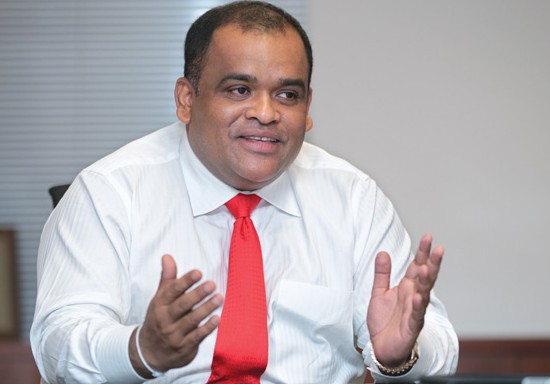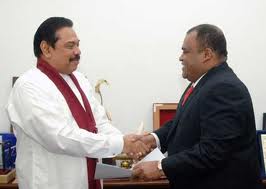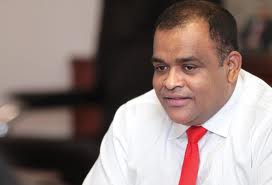Bullets for Water: Militarization comes home to the Sinhala Buddhist nation
“We asked for water tanks; they sent army tanks”
A woman resident of Weliveriya (BBC – 3.8.2013)
They had every reason to feel confident and safe, to expect consideration and justice.
They were almost exclusively Sinhalese and predominantly Buddhist. They would 
have supported the military wholeheartedly (quite a few would have kith/kin in uniform) and rejoiced in the defeat of the LTTE. Many would have done the victory-tour, eating shellfish in Jaffna, worshipping at Nagadeepa, laying flowers at the monument to their war heroes and inspecting Vellupillai Pirapaharan’s bunker. Most would have voted for the Rajapaksas, believing that their present was safe and their future assured in the ‘caring’ hands of the Tiger-vanquishers.
When they realised that the water from their familiar wells had turned toxic, they would have believed that ‘their government’ will succour and protect them. After all, they were not asking for devolution or land/police powers. They wanted free pipe-borne water – a just request given that they were not responsible for releasing pollutants into the waterways. They also wanted the closure of the factory believed to be responsible for contaminating their groundwater.
They did not understand that the Rajapaksas, who waste billions on themselves, turn extremely miserly when it comes to addressing the ordinary problems of little people. And they did not know that the controversial factory belonged to a the premier economic-avatar of the Rajapaksas.
They did not realise that their demand for clean water would transform them from patriots to anti-patriots, from members of the Volk to stooges of the Tamil Diaspora and NGO-lovers.
Why should they, mostly Sinhalese, predominantly Buddhist, Rajapaksa supporters, making an unexceptionable request, peacefully, with Buddhist monks at the helm?
Perhaps, like those ordinary Germans, they blamed insensitive/corrupt functionaries for their plight. Perhaps they thought that once President Mahinda or Minister Basil gets to know, all will be well.
When the army replaced the police, they would have been relieved. This was the army they loved, the army they did bodhi pujas and blood donation campaigns for, the Sinhala army of the Sinhala people.
So, minutes before all hell broke loose, a demonstrator shouted, “We are not the LTTE”. The officer-in-charge promptly responded, “That is why we are even talking” .
But the army did not come to talk. They came dressed for battle, carrying weapons of war. Their appearance and demeanour sent an unmistakably sinister message, but the demonstrators were too mired in myopia to get it. Believing in the hype about ‘Api wenuwen api’, they obviously never thought that ‘Our (Sinhala) Boys’ would be ordered by ‘Our (Sinhala) Government’ to shoot at ‘Us’, the Sinhala people.
They were tragically wrong.
The military shot into the unarmed crowd, without using any other, non/less lethal, crowd-controlling measure.

Dammika Perera is allegedly said to act as chief financier for the Rajapakses as they amass a massive private fortune. Photo shows Perera (R) greeting President Rajapaksa
There were no water cannons, tear gas or even rubber bullets. Live bullets were the patriotic army’s first resort against the patriotic Sinhala crowd led by patriotic Buddhist monks , asking for safe water.
Subsequently, for some hours, Weliweriya became occupied territory, a la North. An unofficial curfew was imposed; people were forced to stay indoors and the injured could not obtain treatment. Power was disconnected and house-to-house searches conducted. The army reportedly shot at and assaulted people sheltering inside a church.
“They attacked barbarically, brutally…. There is a rule of war, not just in Sri Lanka but in the world, hospitals, temples, churches and schools cannot be bombed or invaded. The other thing is when a man comes forward with arms raised you cannot shoot”, says a resident . In this indignant, perplexed soliloquy of a Sinhala man, one can hear the dawning realisation that, perhaps, perhaps, the ‘Humanitarian Operation’ was not quite humanitarian.
Before they fried into the crowd, the army herded media personnel into a vehicle (some were assaulted) and shot at the street lights plunging the area into darkness.
The aim was to combine indiscriminate use of fire-power with zero-coverage, a la Fourth Eelam War.
Fortunately, for now, the terror-tactics are not working. The media gave maximum coverage; people spoke out; Ranil Wickremesinghe and other Opposition parliamentarians visited the area. The people of Weliweriya, because

The controversial factory at Weliweriya is owned by the Hayleys; Dhammika Perera has a near 50% control over the Hayleys . Mr. Perera also owns a large chunk of Sri Lanka’s private sector economy. His Vallibel Group controls “nearly a tenth of listed firms… 28 out of 280” . He is involved in every sector of the economy, from tiles to tourism, from plantations to banking (he is the Chairman of the Sampath Bank); “he also owns stakes in unlisted companies in power generation and gaming” .
Mr. Perera wears another hat; he was appointed the Permanent Secretary to the Ministry of Transport in 2011. There is a clear conflict of interest in a business magnate on an acquisition-spree functioning as a senior bureaucrat.
That is Rajapaksa Sri Lanka.
The Rajapaksas own the state; and they are set to acquire a monopoly-control over the private-sector economy through dummy entrepreneurs.
they are Sinhalese living in close vicinity to Colombo, were not abandoned.
So, not even marginally as horrendous as the North, but an omen, nevertheless, of times ahead.
A Rajapaksa Monopoly
SWRD Bandaranaike “nationalised the buses and communalised the nation” , wrote A Sivanandan. The Rajapaksas are combining monopoly-capitalism with blood and faith nationalism.
The controversial factory at Weliweriya is owned by the Hayleys; Dhammika Perera has a near 50% control over the Hayleys . Mr. Perera also owns a large chunk of Sri Lanka’s private sector economy. His Vallibel Group controls “nearly a tenth of listed firms… 28 out of 280” . He is involved in every sector of the economy, from tiles to tourism, from plantations to banking (he is the Chairman of the Sampath Bank); “he also owns stakes in unlisted companies in power generation and gaming” .
Mr. Perera wears another hat; he was appointed the Permanent Secretary to the Ministry of Transport in 2011. There is a clear conflict of interest in a business magnate on an acquisition-spree functioning as a senior bureaucrat.
That is Rajapaksa Sri Lanka.
The Rajapaksas own the state; and they are set to acquire a monopoly-control over the private-sector economy through dummy entrepreneurs.
Sri Lanka will thus become a fully-owned Rajapaksa concern, politically and economically.
When the people of Weliveriya demanded the closure of a Hayleys-owned factory, they took on a Rajapaksa-avatar. Plus Gampaha is the fief of Basil Rajapaksa. The Weliveriya protest thus became a challenge to Rajapaksa political and economic power.
No crime is that criminal in Rajapaksa Sri Lanka.
The people of Weliveriya, and, through them all Lankan people, had to be taught a lesson in obedience.
The Rajapaksas will now redouble their efforts to shore up the Muslim bogey so that Sinhala-Buddhist South will be too busy worrying about Sharia or Halal to care about the poison in their water; or prices, lousy educational/health standards, crime, abuse or injustice.
The officer-in-charge of the ‘Humanitarian Operation’ in Weliveriya said that the army fired a few shots in the air, after the demonstrators threw homemade bombs and shot with a T56 gun. In that manifestly apocryphal tale, the echo of other lies (‘zero-civilian casualties’ et al) could be heard.
Neither the North nor the South will know any real peace or development, so long as the Rajapaksas are in power and the military is embroiled in civilian affairs. And until the Sinhala masses realise that the Rajapaksas are as bad for Sinhala-Buddhists as Vellupillai Pirapaharan was for Tamils, and that the military is not a national force but a Rajapaksa tool, the country will deteriorate and the South, including Hambantota, will experience other Weliveriyas.
A resident of Weliweriya said, “If they treated us like this for engaging in a demonstration one can imagine the situation in the North. We thought they did something big by finishing the war in our country. Now it looks as if they just killed innocent people ”.
Is the worm opening its eyes and seeing the world for what it is?
